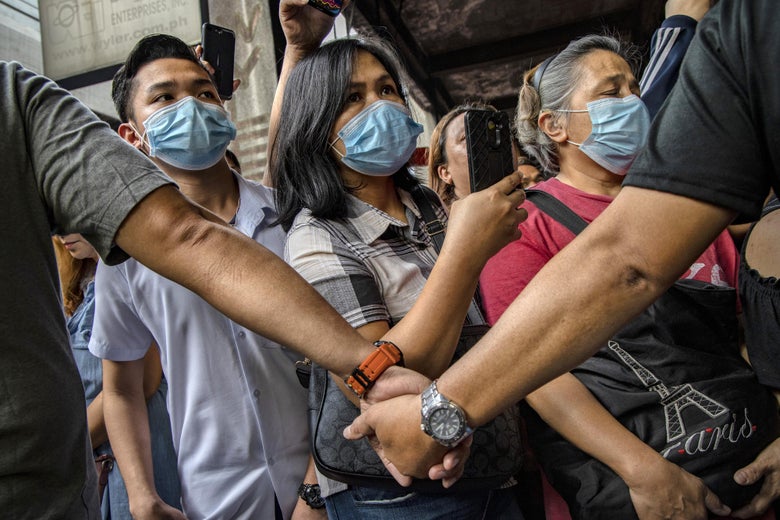
Police officers stand guard as Filipinos hoping to buy face masks crowd outside a medical supply shop that was raided by police for allegedly hoarding and overpricing the masks, as public fear over China’s Wuhan Coronavirus grows, on January 31, 2020 in Manila, Philippines.
Ezra Acayan/Getty Images
A man died of the Wuhan coronavirus in the Philippines, marking the first time someone has died from the new virus outside of mainland China, where officials are scrambling to try to contain the epidemic. Authorities in the Philippines said the 44-year-old Chinese man from Wuhan who appeared to have been infected before arriving in the Philippines had been admitted to hospital on Jan. 25. Although he showed signs of improvement over the past few days after developing pneumonia, “the condition of the patient deteriorated within his last 24 hours resulting in his demise.” His 38-year-old companion is still hospitalized.
Hours before the death was publicly announced, the Philippines became the latest country to place temporary block on travelers from China, except Filipinos. New Zealand also announced new limits on travelers from China, joining the United States and Australia, among others, who have imposed restrictions in a bid to stem the spread of the new virus. Infections in China soared by 2,590 to 14,380 while the death toll rose by 45 to 304. At least an additional 171 cases have been reported in around 20 other countries, including eight in the United States. Although the number of cases is far higher than during the 2002-03 outbreak of SARS, or severe acute respiratory syndrome, the mortality rate of the new virus is lower, suggesting it is less deadly. SARS killed almost 800 people of the approximately 8,000 who were infected.
Experts are warning that as fast as the virus is spreading the truth could be even starker and the outbreak could be much worse than it appears. Plus, it could start spreading much more quickly over the next week or two. A study published in The Lancet found that it is likely that as many as 75,815 people in Wuhan had been infected by Jan. 25 and that the epidemic was doubling every 6.4 days.
The New York Times carried out interviews with Wuhan residents, doctors, and officials to reconstruct how the outbreak became an epidemic and found that in the crucial first weeks since the first symptoms appeared, the government chose secrecy over openness. The Times explains:
In those weeks, the authorities silenced doctors and others for raising red flags. They played down the dangers to the public, leaving the city’s 11 million residents unaware they should protect themselves. They closed a food market where the virus was believed to have started, but didn’t broadly curb the wildlife trade.
Their reluctance to go public, in part, played to political motivations as local officials prepared for their annual congresses in January. Even as cases climbed, officials declared repeatedly that there had likely been no more infections.
By not moving aggressively to warn the public and medical professionals, public health experts say, the Chinese government lost one of its best chances to keep the disease from becoming an epidemic.
“This was an issue of inaction,” said Yanzhong Huang, a senior fellow for global health at the Council on Foreign Relations who studies China. “There was no action in Wuhan from the local health department to alert people to the threat.”
Readers like you make our work possible. Help us continue to provide the reporting, commentary and criticism you won’t find anywhere else.
Join Slate Plusfrom Slate Magazine https://ift.tt/2GKZ7qV
via IFTTT
沒有留言:
張貼留言